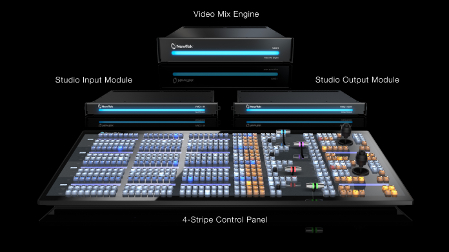NewTek Launches IP Series Video Production Product Line
SAN ANTONIO—NewTek has launched the NewTek IP Series, a software-driven, modular video production system with unlimited access to video sources and video mixing options. Designed to work cohesively in an ecosystem, the NewTek IP Series is the first large production system designed for IP video while also fully backwards compatible with SDI, according to the company. It uses separate scalable high-performance components for the mixing and control, input, and output of sources allowing virtually unlimited scalability. Video, audio, and control signals from these components are transferred digitally using NewTek’s Network Device Interface (NDI) technology allowing multiple video systems to identify and communicate with any other system over a standard computer network. The result is a fully customizable IP workflow solution with the flexibility to handle the most demanding production needs.

“Built from the ground up to take advantage of modern IP infrastructures and software-based video processing, this new product line, the NewTek IP Series, is the first fully scalable production ecosystem ever, and represents a true paradigm shift in the way live mixing technology works,” said Dr. Andrew Cross, president and chief technology officer for NewTek. “With distribution of TV content flowing unstoppably over IP, it only makes sense that production does the same. Many see it coming, only NewTek can deliver a complete solution today.”
With the NewTek IP Series, current and future resources can be integrated through an interconnected production workflow using commercial-off-the-shelf network infrastructure. Implementing NewTek’s live production software, NewTek IP Series users can access more workflow possibilities and expansion capabilities. Additionally, facilities and organizations don’t have to abandon existing investments in SDI infrastructure or implement high-priced, high-bandwidth networking to migrate to IP.
The nucleus of the NewTek IP Series is the NewTek VMC1 Video Mix Engine capable of switching up 64 source channels, including 44 external inputs (each with key and fill) and full mixing control with 8 M/Es with full re-entry, plus PREVIZ. Each Video Mix Engine includes integrated compositing, a sophisticated macro automation engine, and a flexible and scalable effects system with almost unlimited matting, DVE, transitions, overlays, virtual sets, real-time data, etc. Multiple NewTek VMC1 Video Mix Engines can be placed on the network allowing for both expansion and full redundancy as needed, keeping up with demands of any size of production.
The NewTek VMC1 4S Control Panel is the tactile interface that connects the operator to single or multiple engines for precise control of the production. Paired with the VMC1 Video Mix Engine over a network, the NewTek VMC1 4S Control Panel offers comprehensive functionality with four independently assignable stripes and premium hardware mechanics that are intuitively arranged and ergonomically designed to ensure optimal live performance.

The NewTek VMC1 IN Studio Input Module allows up to 4 SDI or IP inputs per module recognized by the NewTek VMC1 Video Mix Engine. Modules can be added at any location on the network to increase camera/source count as necessary. Adding new dimensions to production operations, each module includes a multiviewer with return video feed and capability to ISO record to network storage. The NewTek VMC1 OUT Studio Output Module is a 4 channel multi-format modular video delivery hub that can reside anywhere on a network.
The NewTek VMC1 Video Mix Engine, NewTek VMC1 4S 4-Stripe Control Panel , and the NewTek VMC1 IN Studio Input Module are available immediately. The NewTek VMC1 OUT Studio Output Module will be available in Q4 2016.
Get the TV Tech Newsletter
The professional video industry's #1 source for news, trends and product and tech information. Sign up below.
Tom has covered the broadcast technology market for the past 25 years, including three years handling member communications for the National Association of Broadcasters followed by a year as editor of Video Technology News and DTV Business executive newsletters for Phillips Publishing. In 1999 he launched digitalbroadcasting.com for internet B2B portal Verticalnet. He is also a charter member of the CTA's Academy of Digital TV Pioneers. Since 2001, he has been editor-in-chief of TV Tech (www.tvtech.com), the leading source of news and information on broadcast and related media technology and is a frequent contributor and moderator to the brand’s Tech Leadership events.

